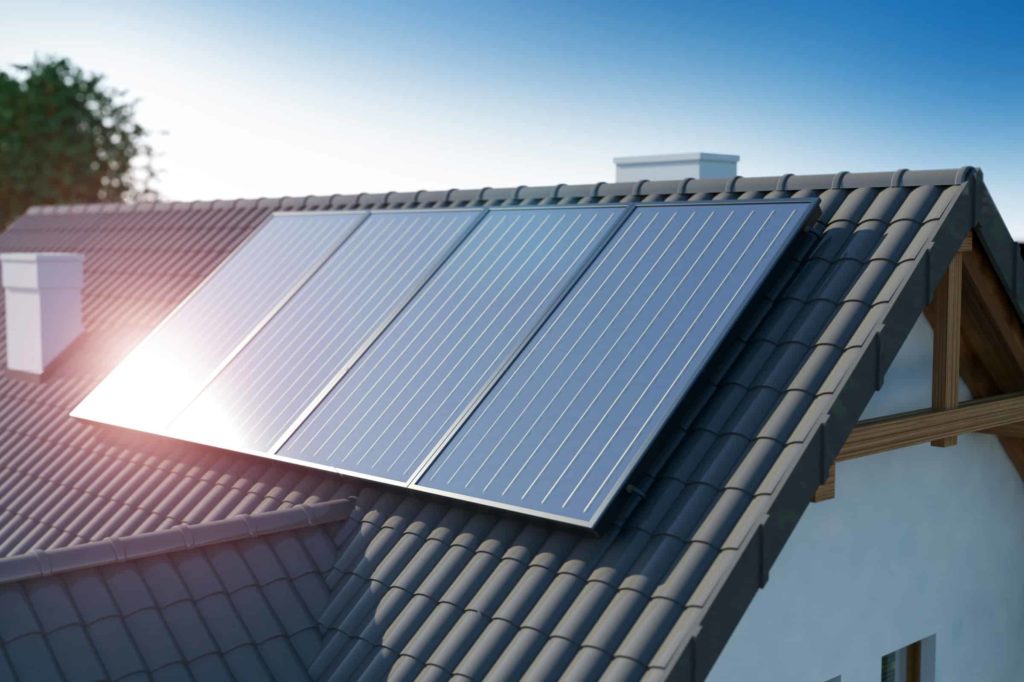Solar panel technology has come on leaps and bounds in recent years. Not only has the efficiency of solar panels gone up considerably, but the price of the units themselves has collapsed. This fall makes them an attractive option for homeowners looking to save a bit of money on their utility bills.
The UK is famously rainy, with more than 70 per cent of days overcast in a typical year. But’ it’s wrong to assume that this means that the country isn’t suitable for solar panel installation. Solar panels will still generate a considerable amount of electricity, even on a cloudy day.
So, can you get solar panels on your house? Let’s take a look.
Is Your Roof Large Enough?
Solar energy generation requires a large area to collect incoming solar radiation. So, if you’re a homeowner, you either need space on your roof or a patch of land you’ll be willing to dedicate to solar panels.
Most homeowners opt to install solar on their roofs. It’s convenient, out of the way, and helps to protect roofing materials from damage.
The size of your roof matters: you need your roof to have sufficient area to provide the solar collection capacity to meet your household energy needs.
You start seeing real economic returns from 2kW (kilowatt) systems and up. For a system of that size, you’ll need at least 12 square meters of roof space. That 12 metres-squared will typically accommodate eight panels measuring 1.75 by 0.9 metres, each generating around 250 Watts.
You can then scale the number of panels to meet your needs in 250 W increments. Take a look at the following examples:
- 12 panels will generate 3 kW of power and require 18 square meters of roof space.
- 14 panels will generate 3.5 kW of power and require 21 square meters of roof space.
- 16 panels will generate 4 kW of power and require 24 square meters of roof space.
- 18 panels will generate 4.5 kW of power and require 27 square meters of roof space.
You can see the pattern.
The next question to ask is how much electrical energy your household typically uses (not including any gas boilers). If you want to rely on solar panels, you’ll want them to exceed your overall usage. A medium energy-using home in the UK gets through around 3,100 kWh per year. A high-usage house can burn through up to 4,600 kWh per year. The more energy you use, the bigger the space you’ll need on your roof (or wherever you want to install your panels).
Is Your Roof The Correct Pitch?
In the UK, the ideal roof angle for solar panels is somewhere between 35 and 40 degrees directly facing the trajectory of the sun as it crosses the sky. However, you can install solar panels on roofs with pitches anywhere between 10 and 60 degrees. Remember, however, that you won’t generate as much electricity as panels arranged at the optimal angle.
Is Your Roof Structurally Sound?
A typical solar panel weighs about 30 kilograms. Alone, that isn’t a significant amount. But add fifteen panels, and you’re looking at nearly half a metric ton sitting on your roof, weighing about as much as a small cow. You may, therefore, want to check that your roof is structurally sound before installing any panels.
How Much Does It Cost To Install Solar Panels?
The cost of solar panels depends on the size and configuration of the system. The larger the system you install, the bigger the savings. However, you will pay more upfront.
Here are some typically cost ranges, including installation, for systems of different sizes:
- 2 kW: £2,800 – £4,000
- 3 kW: £3,500 – £5,000
- 4 kW: £5,600 – £8,000
The cost of solar panels varies with your location. Those living in the south-east and London will pay more than those living in the north-east. Those in the west country will pay slightly above average while those in the midlands below average.
Rent Your Roof Space
If you can’t afford the cost of solar panels outright, you can rent your roof space to energy companies on the Rent-A-Roof scheme. The government designed the programme to benefit both homeowners and energy producers. Homeowners could enjoy electricity generated by free solar panels installed by the energy company, and energy companies would get money from the Feed-In-Tariff.
The fall in the cost of solar panels, however, means that the Rent-a-Roof scheme isn’t as popular as it once was. You can still rent your roof out if you like, but it often makes better sense to sell energy directly. The Feed-in Tariff closed in March 2019, but it is being replaced by the Smart Export Guarantee (SEG) coming into force in on 1st January 2020. Through the SEG, you’ll be able to sell energy back to the grid and avoid problems in the future when trying to sell your home. There’s no ambiguity over who owns the roof.
Planning Permission
Unless your home is a listed building, you don’t need planning permission for roof-mounted solar PV in the UK. If you want to install solar anywhere else, however, you may need to ask the local authorities for approval.
Can You Make A Return On Solar Panels In The UK?
You can make a positive financial return on solar roof installation in the UK (even with the terrible weather). The initial solar installation cost is fixed. But once you’ve paid that, you have free electricity generation for life. The cost of supplying a marginal unit of energy from solar panels is effectively zero.
Calculating your profit from installing solar is tricky. Not only do you have to estimate the total value of energy-saving per year, but you also have to discount future savings from the present to account for the opportunity cost of capital. When you do this, you find that solar PV systems larger than 2 kW make a handsome return for homeowners over twenty years.
The following are estimated profit scenarios over the following 20 years versus sticking with regular utility supplies:
- 2 kW system: £3,800
- 3 kW system: £5,630
- 4 kW system: £6,750
As you can see, there are profits to be made. What’s more, because solar panels last a long time, those you install today could still be working for you for a very long time to come. The overall lifetime savings are substantial.
Where Are You Making Money When You Install Solar Panels?
Sell Energy Back To The Grid
Most homeowners don’t use all of the electricity that their solar panels generate and can sell it back to the grid. The Feed-in Tariff is a price the government sets for buying the energy you create. The prices change from quarter to quarter and hour to hour, depending on current demand, but you can make a sizeable amount of money through this mechanism, sometimes called grid trade solar. New solar panel owners can’t join the Feed-in Scheme but will be able to sign up for the SEG next year.
Save On Utility Bills
The second way you save money is through savings on utility bills. The energy you get from active solar panels is free.
How much can you save during a typical year? A 3kW system will probably cut your energy bills, net of selling energy back to the grid, by around £570 per year. However, your total savings will depend on your energy-usage patterns, your location, and whatever arbitrary buying prices the government sets for selling energy back to the grid.
Conclusion
So what’s the conclusion to all of this? In general, the cost of installing solar panels is going down thanks to falling unit prices. And over the long term, you should make a profit, provided you have a standard pitched roof which faces vaguely south. Of course, there are non-financial benefits too, such as saving the planet.



